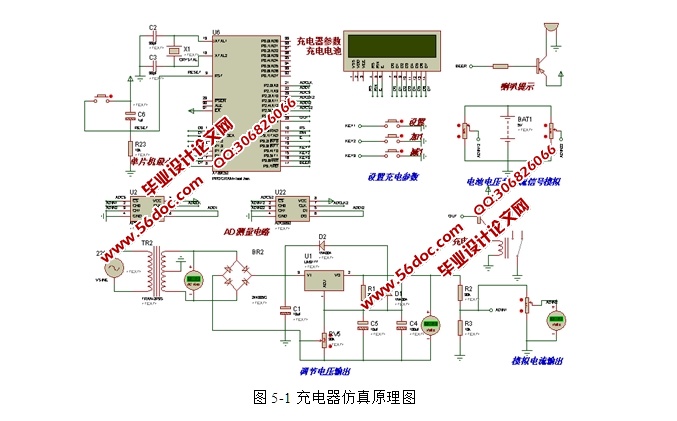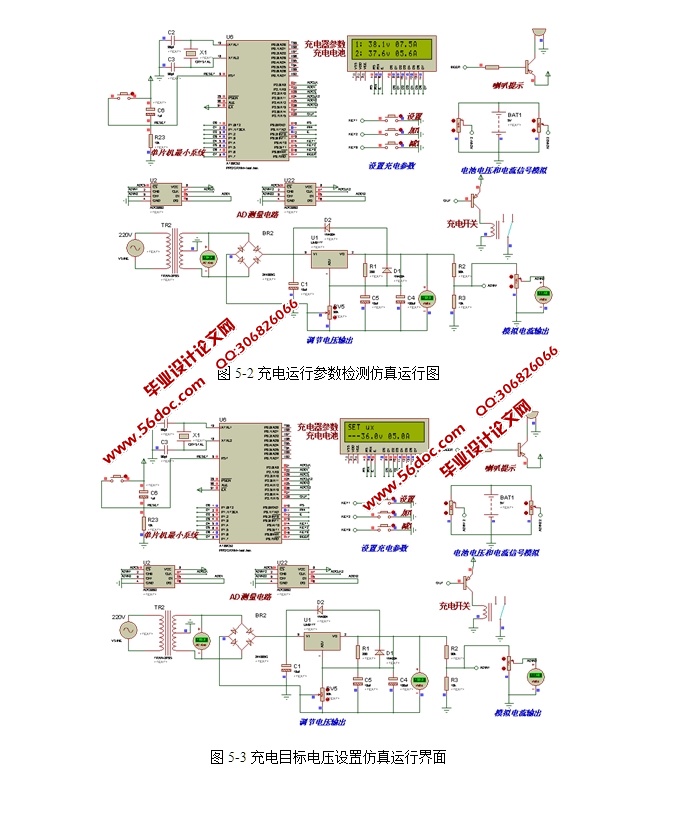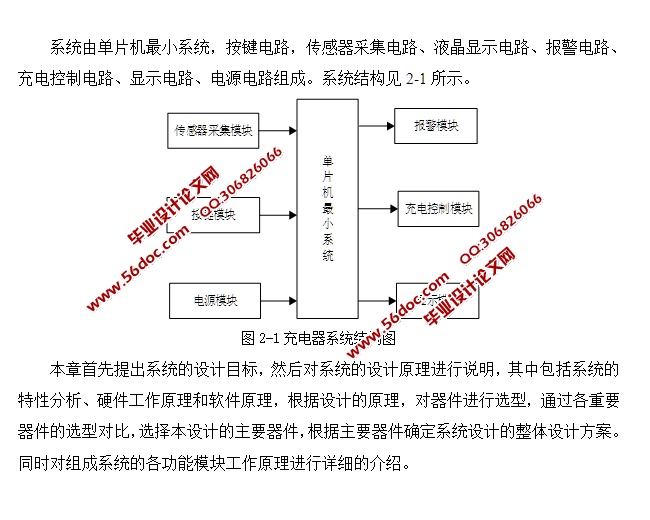基于单片机控制的智能充电器设计(附仿真原理图,Proteus仿真程序)(论文11400字,Proteus仿真程序)
摘 要
在能源面临危机的今天,绿色环保新能源受到全世界各国的关注的同时,也得到了大规模的应用。电动车出现为能源危机的解决和大气环境污染治理,提供了良好解决途径。作为电动车重要组成部分,如何研制性能良好的智能充电器,对电动车的行业发展具有重要的意义。
本文利用STC89S52单片机设计一款智能充电器的控制系统,通过对电压传感器和电流传感器的检测,当检测充电电压和电流大设置值时,自动断开充电电路。本设计由软件和硬件两部分组成,硬件设计对单片机最小系统、电压电流采集电路、充电控制电路、按键电路、液晶显示电路、报警电路等进行设计,使控制器具备电压、电流检测,系统参数显示,自动断电控制等功能;软件设计方面对控制器的软件驱动程序进行设计。并利用Protues软件进行可行性仿真,对软件和硬件设计进行验证。
关键词:控制器;充电器;蓄电池
Abstract
In the energy crisis today, the new green energy, environmental protection and new energy by the attention of countries all over the world at the same time, has also been a large-scale application. Electric vehicle energy crisis resolution and atmospheric pollution control to provide a better solution. As an important part of the electric car, how to develop the good performance of the intelligent charger, to the electric car industry development has important significance.
The STC89C52 control system design of a intelligent charger, detection of current and voltage sensor, when detecting the charging voltage and high current setting value, automatically disconnect the charging circuit. The design consists of two parts, hardware and software, the hardware design of the smallest single-chip system, voltage and current sampling circuit, charging control circuit, key circuit, LCD display circuit, alarm circuit design, the controller with voltage, current detection, system parameters show that automatic power-off control; software design of the controller software driver design. And the Protues software for feasibility simulation, software and hardware design verification.
Key words: controller; charger; battery
本文以一个智能充电器作为研究对象,重点研究了智能充电器的原理和控制系统设计,选取单片机核心控制单元,依据高可靠性单片机实现控制系统的稳定可靠运行。控制系统选用了传感器和模数转芯片实现对输入各电流和电压的检测,利用按键、液晶显示和蜂鸣器组成人机接口电路实现信息的传送。
本文的结构安排如下:
第1章引言部分首先介绍了选题背景及意义;
第2章介绍提出设计目标,根据设计目标提出设计思想,进行器件选型,确定整体系统框架;
第3章充电器的硬件电路设计,
第4章介绍了软件实现;
第5章对设计进行总结。



目 录
一、绪论 1
1.1 选题背景及意义 1
1.2国内研究现状 1
1.电池技术得发展 1
2.充电技术的发展 1
1.3研究的内容及结构安排 2
二、系统设计方案分析 3
2.1设计目标 3
2.2设计思想 3
2.2.1硬件实现原理 3
2.2.2软件实现原理 3
2.3主要器件选型 4
2.3.1主控器选型 4
2.3.2按键模块选择 5
2.3.3显示电路选择 5
2.3.4报警模块选择 5
2.3.5供电方式选择 6
2.3.6传感器选型 6
2.4 系统总体框架 6
三、 系统硬件设计 8
3.1单片机最小系统 8
3.1.1 单片机最小系统 8
3.2 充电控制电路 10
3.3显示电路设计 11
3.4按键电路设计 11
3.5充电控制电路设计 11
3.6报警电路设计 12
3.7传感器采集电路设计 13
3.7.1电流变送器介绍 13
3.7.2传感器采集电路设计 14
四、系统软件设计 15
4.1主程序设计 15
4.2充电界面显示子程序设计 16
4.2设置目标充电电压程序 16
4.3设置目标充电电流程序 17
五、系统仿真 18
5.1仿真软件介绍 18
5.2仿真建立步骤 18
5.3仿真原理图设计 18
5.4仿真原理介绍 19
5.5仿真运行结果分析 20
总结 21
致 谢 22
参考文献 23
|







